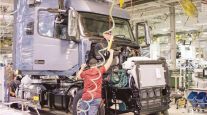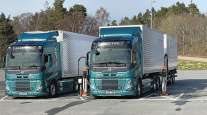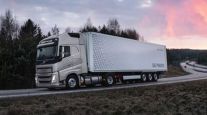Managing Editor, Features and Multimedia
Volvo’s Voorhoeve Sees Growing Market for Electric Trucks, Driver-Assist Tech
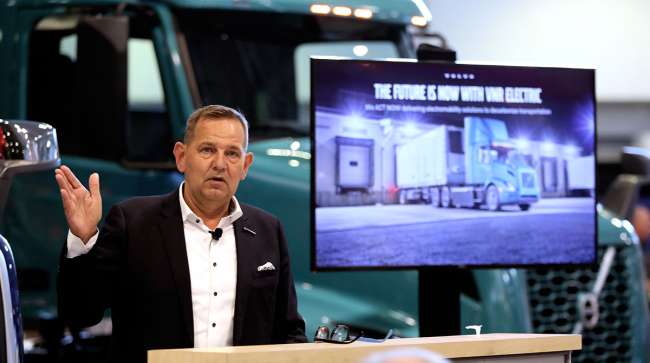
[Stay on top of transportation news: Get TTNews in your inbox.]
NASHVILLE, Tenn. — Volvo Trucks North America CEO Peter Voorhoeve sees expanding opportunities for electric-powered trucks and further growth for driver-assistance technologies in this time of transformation for the commercial vehicle market.
Voorhoeve addressed those trends and other industry issues Oct. 26 during a one-on-one interview with Transport Topics at American Trucking Associations’ 2021 Management Conference & Exhibition.
As Volvo continues to roll out its VNR Electric Class 8 model, the truck maker is delivering those battery-electric vehicles not only to its largest fleet customers, but also to a rising number of medium-size companies.
Two Volvo VNR Electric trucks will soon transport parts and components to our assembly plant in Virginia in the US. This is one step we take to reduce Co2 emissions from our own operations. #electrification #electrictrucksinreality #electricvehicles #sustainability #volvotrucks — Volvo Trucks (@VolvoTrucks) October 28, 2021
In some cases, shippers and their transportation providers are investing in these electric trucks to achieve their corporate sustainability goals, Voorhoeve said.
Government incentives, however, will remain necessary for wider adoption because these zero-emission vehicles come with a higher total cost of ownership than the diesel models that dominate the industry today.
“We do need incentive programs,” Voorhoeve said.
Electric trucks also have their own unique maintenance requirements. To meet those needs, an increasing number of Volvo dealerships across North America are working toward electric vehicle certification.
RELATED: Volvo Trucks outlines Carbon-Free Vision
Voorhoeve said about 30 Volvo dealers are on track to obtain EV certification by the end of the year, but over time, he expects the entire Volvo dealership network eventually to become certified to service electric trucks as Volvo works to cut carbon-dioxide emissions by 50% in 2030 and 100% in 2040.
“It’s not an experiment. It’s not a tryout. It’s not a pilot. It’s a part of our offering,” Voorhoeve said. “Our Volvo dealers all sell the full range, and they will be certified selling the full range.”
One open question for commercial vehicle electrification is how and when a secondary market for used battery-electric trucks will emerge. In some cases, fleets may operate EVs longer than their diesel models. In others, companies may find other ways to repurpose vehicle batteries that reach the end of their first life.
“I think it’s going to be a little bit all of the above,” Voorhoeve said.
Volvo Group has created a separate business unit, Volvo Energy, to support truck electrification and environmental sustainability, including the development of charging infrastructure and refurbishing and reusing electric-vehicle batteries. That could include repurposing old EV batteries for uses such as residential energy storage.
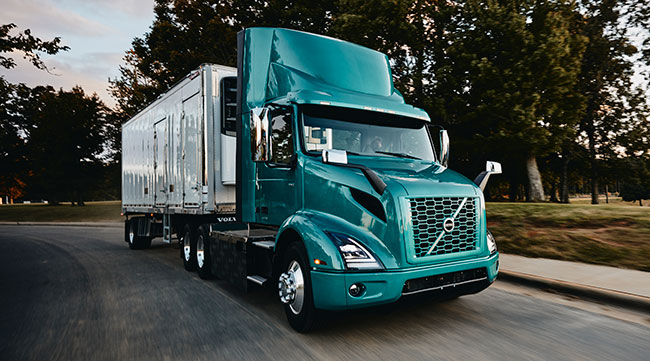
Volvo VNR Electric truck on the road. (Patrick Daly)
While Volvo sees battery-electric trucks as one core pillar of its product lineup moving into the years ahead, the truck maker also is pursuing fuel cell technology and more efficient combustion engines.
“It’s a three-pronged strategy,” Voorhoeve said. “We’ll see battery-electric, we’ll see fuel cell-electric, and we will still see the internal combustion engine. That’s the path we will follow going into the future.”
Meanwhile, in the near term, Voorhoeve predicted that demand for new trucks will continue to outpace supply as parts shortages and worldwide supply chain challenges place limitations on manufacturers.
“Everybody’s looking for more capacity,” he said.
.@VolvoTrucksNA President Peter Voorhoeve outlines the truck maker’s plans to achieve fossil-free transportation by 2050 at a press conference here at #ATAmce21. @Truckingdotorg pic.twitter.com/NxgNelYLvd — Seth Clevenger (@SethClevenger) October 24, 2021
It’s unclear when these supply chain issues will normalize, but it won’t be before Christmas, Voorhoeve predicted.
Another issue that is top-of-mind for Volvo’s fleet customers, Voorhoeve said, is driver recruiting and retention.
While Volvo has long focused on making its trucks a driver retention tool for fleets, the current labor shortage amid the economic recovery from the coronavirus pandemic provides further encouragement for the truck maker to continue investing in the driver environment in its trucks, he said.
Advanced driver-assist features also are expanding and gaining customer acceptance.
Volvo said the take rate for automatic emergency braking has reached 60%.

In this episode, host Michael Freeze asks, how are companies saving money by leasing trucks rather than owning? For answers, we speak with Jim Lager of Penske Truck Leasing and Al Barner of strategic fleet solutions at Fleet Advantage. Hear a snippet above, and get the full program by going to RoadSigns.TTNews.com.
In recent years, steering assistance also has become an option on new trucks, but has yet to reach the same level of adoption.
Volvo Dynamic Steering is designed to aid drivers by adding torque at the wheel to reduce strain on drivers’ muscles and improve stability in conditions such as crosswinds.
Volvo said the take rate for VDS currently stands at about 5%. Some companies are spec’ing the steering assist feature as a driver incentive, Voorhoeve said.
At the same time, Volvo continues to pursue highly automated trucks through its Volvo Autonomous Solutions division and via its partnership with self-driving truck developer Aurora, which is working to pave the way for unmanned trucks.
For Voorhoeve, the successful introduction of fully automated trucks would offer fleets a new way to move freight, but would not reduce the industry’s need for professional drivers.
“We believe that there are certain applications where it makes sense to go with autonomous trucks, and it will be in certain segments,” he said. “I don’t think we should really link that to driver jobs. I think drivers will always be necessary.”
Want more news? Listen to today's daily briefing below or go here for more info:


